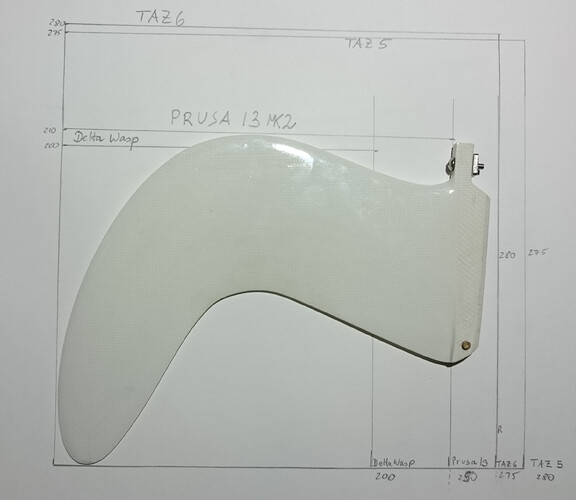My minimalistic approach to the 3D Tough Fin Base design: One extruded polygon and the rest are all cylinders.
Unfortunately it turns out to be quite expensive to buy a suitable 3D printer, and online printing is surprisingly expensive, too.
It could cost around AU$200.- to print both halves of the split mould, and a suitable printer would cost AU$1300.- .
For now, I’ll try a bit longer to manufacture a near perfect TFB by hand. But it’s only a matter of time before I will cave in and buy a printer.
//194mm x 194mm to allow 3mm thick mould walls on 200 x 200 printer.
difference() {
color("blue",0.1)
translate([-3,-100,-3])
cube([200,200,7.5]); centre=true;
color("red",0.25)
translate([0,97,0]){
rotate([90,0,0]){
linear_extrude (height = 194, centre = false, twist = 0)
polygon(points=[[0,0.05],[0,8.95],[24,9],[24,0]]);
translate([40,8.95,93])
rotate([90,90,0]){
cylinder(h=8.9,r=40);}
translate([80,8.95,80])
rotate([90,90,0]){
cylinder(h=8.9,r=35);}
translate([100,8.95,70])
rotate([90,90,0]){
cylinder(h=8.9,r=35);}
translate([130,8.95,60])
rotate([90,90,0]){
cylinder(h=8.9,r=33);}
translate([160,8.95,60])
rotate([90,90,0]){
cylinder(h=8.9,r=28);}
translate([169,8.95,68])
rotate([90,90,0]){
cylinder(h=8.9,r=25);}
translate([177,8.95,58])
rotate([90,90,0]){
cylinder(h=8.9,r=15);}
translate([153,8.95,43])
rotate([90,90,0]){
cylinder(h=8.9,r=15);}
translate([153,8.95,75])
rotate([90,90,0]){
cylinder(h=8.9,r=15);}
translate([146,8.95,41])
rotate([90,90,0]){
cylinder(h=8.9,r=15);}
translate([110,8.95,46])
rotate([90,90,0]){
cylinder(h=8.9,r=15);}
translate([120,8.95,83])
rotate([90,90,0]){
cylinder(h=8.9,r=15);}
translate([77,8.95,58])
rotate([90,90,0]){
cylinder(h=8.9,r=15);}
translate([57,8.95,66])
rotate([90,90,0]){
cylinder(h=8.9,r=15);}
translate([70,8.95,106])
rotate([90,90,0]){
cylinder(h=8.9,r=15);}
translate([26,8.95,66])
rotate([90,90,0]){
cylinder(h=8.9,r=15);}
translate([26,8.95,124])
rotate([90,90,0]){
cylinder(h=8.9,r=15);}
}
}
}


















